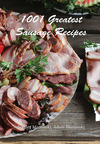Meats and Sausages
Torry Kiln Smokehouse
Torry Kiln Smokehouse was a smokehouse designed in 1939 at the Research Center Torry in Aberdeen, Scotland, that revolutionized the fishing industry. It allowed for precise control of smoking parameters like air temperature, speed, and humidity. As a result, the finished product was always of consistently high quality.

All previously built smokehouses depended on a natural draft movement (air going up) without any means of humidity control. The Torry Kiln design incorporated a motor-driven fan, electric heaters, temperature sensors, air diffusers, and even a photoelectric eye for smoke density control.
Torry Kiln Smokehouse-Cross Section View

Smoke was generated by three independently controlled fireboxes (1) that were standing above each other. Each had its own loading door and smoke damper. That provided a large smoke-generating area without taking up much space. It also prevented soot and other large unburnt particles from reaching the hanging fish. The smoke would enter a common duct (2) and would be deflected by aerofoils (3) towards the electric heater (4). The motor-driven fan (5) would blow the heated air through the adjustable vertical blinds (6) towards the aerofoil plates (7). At the bottom of the diffuser channel, the air had to pass through the inlet diffuser wall (8) that contained many individually adjustable openings for the air flow adjustment. From there, the heated air or smoke would pass through loaded fish trolleys (9). Inside the smoke chamber, there was an additional booster electric heater (10). The air/smoke leaving the chamber had to pass through the outlet diffuser wall (11) that consisted of fully adjustable openings. The inlet and outlet diffuser walls allowed for a very uniform air flow in all areas of the smokehouse. At the bottom part of the channel, there was a recirculation damper (12) that controlled how much air was going out to the chimney (13) and how much air was returning back towards the fan (5). Fresh air was also brought into the same area (14). Temperature sensors (15) controlled heaters (4 and 10).
















